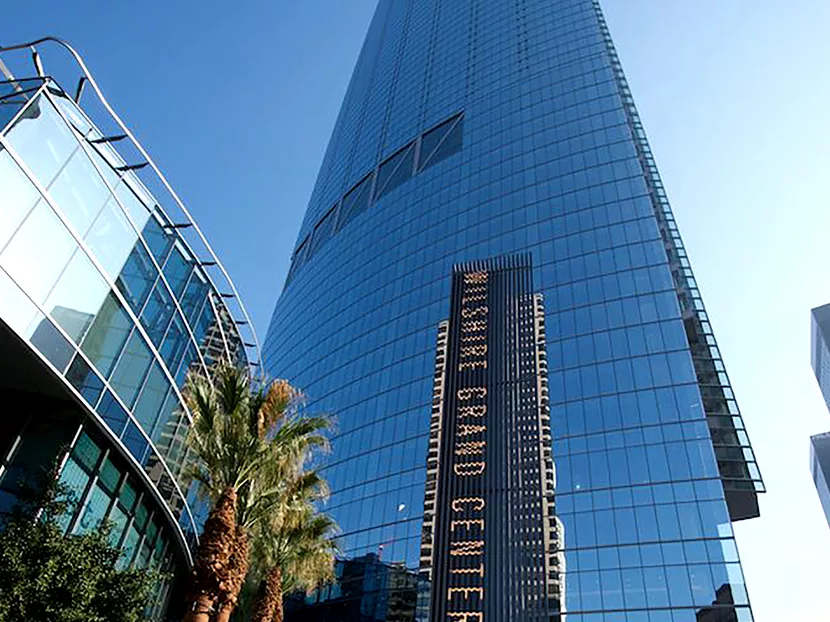More than 2,200 people were involved in the construction of the Wilshire Grand Center, now the tallest building in Los Angeles, including hundreds of mechanical contractors who installed heating and cooling systems.
Deconstruction of the iconic 1950’s-era Wilshire Grand Hotel began in 2012 to make way for the skyline-changing new hotel, offices and retail space. In the footprint of the old hotel, the building of the 73-story glass and steel skyscraper began in 2014, hailed from the start as a pinnacle of modern design and an industry-leading example of how an integrated design approach involving the fields of architecture, engineering and construction can achieve safety, efficiency and sustainability goals.
With an HVAC system accounting for as much as 50 percent of a commercial building’s energy use, designing efficient heating and cooling systems was critical to meeting the project’s sustainability goals and its achievement of LEED Gold status. Working with AC Martin Architects and general contractor Turner Construction Co., ACCO Engineered Systems completed the design of the mechanical systems. For the hydronic HVAC system, ACCO worked with California-based Dawson Co., a Xylem Bell & Gossett manufacturer’s representative.
“A major challenge on the project was that construction had to begin prior to completion of the design — and the budget was already set,” said John Boncich, senior vice president, ACCO Engineered Systems. “We knew support from the Dawson and Bell & Gossett teams would be important from a technical stand-point and also in meeting critical milestone dates.”
Orchestrating the construction of a skyscraper is a complex undertaking, and ensuring both materials and workers are on site when they are needed is key, particularly one with such aggressive design and construction schedules. In a project the size and scope of the Wilshire Grand Center, keeping to the timeline is vital to the project’s success.
“A 73-story building takes years to build, so project coordination in regard to product lead times and deliveries had to be in line with the construction schedule,” said Manual Masso, Dawson Co. vice president of Commercial Sales.
The construction site posed additional challenges — at just 2.8 acres, the site offered no space to store materials. “Deliveries were lifted by cranes to the floors when they were needed,” Masso said.
HVAC design
The 1,100-foot-tall building is anchored by a seven-level podium structure that houses retail, restaurants, meeting rooms, ballrooms and a swimming pool. On top of the podium is 400,000 square feet of office space. The Intercontinental Los Angeles Downtown hotel, with about 900 rooms on floors 31 to 66, a 70th-floor sky lobby and bars and restaurants on floors 69 and 71, occupies the building’s tower structure.
Efficient use of energy within buildings is a primary focus of industry guidelines, such as ASHRAE 90.1, that have a direct impact on HVAC system design and installation. In addition, California’s Title 24 is a set of energy-efficiency rules that govern new building construction to improve water efficiency along with efficiency standards for mechanical systems. The Wilshire Grand Center design team, led by AC Martin, worked with energy consultant Glumac to perform extensive energy modeling to design the glass façade, which informed the design of the HVAC and lighting systems — the two biggest energy users within a building.
The building’s HVAC system features a central plant with high-efficiency chillers and condensing boilers that supply chilled and hot water to the 2.1-million-square-foot building. The design consisted of a combination of pumps to supply the chilled and hot water to the podium and office levels and pumps to serve the thermal energy storage system (TES) on the podium’s second level. The TES charges a large water tank overnight to reduce the number of chillers needed to operate the building during the day. Plate and frame heat exchangers isolate the building’s pressure zones from each other.
Pumps designed specifically for commercial hydronic systems provide radiant floor heating and cooling in the ground-floor lobby and in the sky lobbies. Inside the mechanical room on the 30th floor, pumps provide climate comfort to the hotel guest rooms via four pipe fan coil units and air handlers.
Partner in design
In large-scale commercial building projects around the country, Xylem’s Bell & Gossett brand is integral to accomplishing energy goals through high-efficiency HVAC and plumbing system design.
“Pump selection centered around versatility and robustness to achieve efficiency targets,” Masso said. “In addition, selecting pumps with a compact design took up less space in the mechanical room, which translates into more saleable space within the building, a priority in all commercial building projects today.”
“Our technologically advanced and reliable system solutions paired with the expertise and superior customer service of our teams and our manufacturer’s representatives are why we are trusted partners in the design-build process,” said Xylem’s Mark Handzel, vice president, Product Regulatory Affairs and CBS/HVAC Business Unit Americas. “The Wilshire Grand Center presented numerous challenges for system design that met project goals while supporting a compact footprint.”





